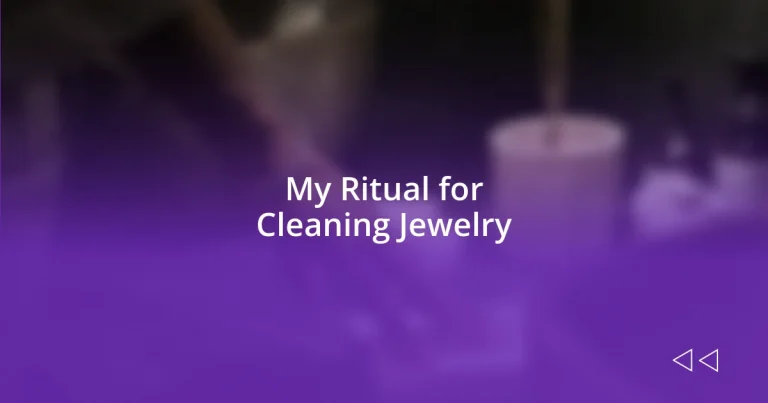Key takeaways:
- Different jewelry types require specific cleaning methods; gentle approaches are essential for delicate materials like pearls and softer stones.
- Gathering the right cleaning supplies, such as mild soap and soft brushes, is crucial for effective and safe jewelry maintenance.
- Recognize when professional help is needed for intricate or damaged pieces to avoid unintentionally causing further harm.

Understanding Jewelry Types
When I first began exploring my jewelry collection, I was surprised by how varied the types can be—each piece has its own story. From sparkling diamonds to colorful gemstones, each material not only varies in appearance but also in the care it requires. Have you ever thought about how different metals, like gold, silver, or platinum, can affect the longevity of your favorite pieces?
I remember the first time I cleaned my pearl necklace; I was nervous because I had heard they’re quite delicate. Pearls need gentle handling and specific cleaning techniques due to their porous nature, which can absorb dirt and oils. How do you feel about caring for softer stones compared to more durable ones like sapphires or rubies? Understanding their composition can make all the difference in how we treat them.
Different styles, like vintage or contemporary, often tell us about the eras they come from. I often find myself drawn to vintage jewelry, not just for its beauty but for the history that comes with it. Have you ever wondered what stories your jewelry could tell if it had a voice? Each type invites us to appreciate the craftsmanship and cultural context behind its design, deepening our connection to the pieces we cherish.

Choosing the Right Cleaning Method
Choosing the right cleaning method can be crucial in maintaining the beauty and longevity of your jewelry. For instance, when I discovered that warm soapy water could refresh my diamond ring, I was thrilled. I had been hesitant to use any chemicals, thinking they would harm the metal or stone; it turned out that simple, gentle cleaning made all the difference.
Over time, I’ve learned to appreciate the nuances of each cleaning method, particularly after a mishap with my favorite sterling silver bracelet. I had used a harsh polish that scratched its surface, teaching me the importance of knowing which products are suitable. It’s fascinating how specialized cleaners exist for various materials; for example, ultrasonic cleaners can be fantastic for many gems but are a no-go for softer stones which could get damaged.
Consider the type of jewelry and its materials when choosing your cleaning method. I often assess my pieces with a loving gaze, asking myself, “What’s best for you?” Having a small checklist for each type of jewelry can ease this decision. To help you out, I’ve put together a comparison table below to illustrate some common cleaning methods along with their pros and cons.
| Cleaning Method | Pros | Cons |
|---|---|---|
| Soapy Water | Gentle and safe for most materials | Not effective for heavy tarnish |
| Ultrasonic Cleaner | Deep cleans settings and surfaces | Not suitable for delicate stones |
| Commercial Cleaners | Designed for specific materials | Can contain harsh chemicals |
| Professional Cleaning | Expert care and restoration | Can be costly |

Gathering Necessary Cleaning Supplies
Gathering the right cleaning supplies is truly the first step toward maintaining the beauty of your jewelry collection. I remember when I accidentally used a dish soap that left a sticky residue on my favorite earrings—what a mess! Now, I ensure I have the right materials on hand, which not only saves time but also protects my treasures.
Here’s a simple list of supplies I usually gather before starting my cleaning ritual:
- Mild dish soap (make sure it’s free of harsh chemicals)
- Soft bristle toothbrush (to gently scrub intricate designs)
- Microfiber cloth (for polishing without scratching)
- Small bowl (for soaking pieces in soapy water)
- Dental picks or other soft tools (for getting into tiny crevices)
Having these essentials ready creates a sense of calm for me, as I know I’m equipped to care for my precious pieces thoughtfully. It’s all about making the cleaning process as smooth and enjoyable as possible!

Step by Step Cleaning Process
Once I’ve gathered my supplies, I dive right into the cleaning process. I like to start by filling a small bowl with warm water and a few drops of mild dish soap. It’s amazing how just a few minutes of soaking can loosen grime and tarnish! I remember seeing my worn-out silver ring suddenly regain a spark of life after a short soak; such a delightful surprise!
Next, I gently use a soft bristle toothbrush to scrub the jewelry. It may seem simple, but don’t underestimate the power of a careful approach. Let’s be honest; I’ve had moments where I got a bit too enthusiastic with scrubbing and scratched a few precious pieces. Now, I remind myself to treat each item as if it were a beloved family heirloom, being mindful of any delicate areas that might require a lighter touch.
Finally, I rinse the pieces under warm water and pat them dry with a microfiber cloth. This stage is like a mini-reveal, where I can reflect on how much better they look! I often catch myself admiring how the shimmering surfaces reflect the light—every time it’s as if I’m unearthing a hidden treasure. It’s rewarding to see how a little bit of effort can bring out the jewelry’s natural beauty.

Tips for Different Materials
When it comes to cleaning gold jewelry, I find that a gentle approach works best. Gold can easily tarnish and lose its luster if subjected to harsh chemicals, which is a lesson I learned the hard way after using an abrasive cleaner once. Now, I stick to a mix of warm water and a splash of mild dish soap, gently scrubbing with a soft toothbrush. Have you ever seen how quickly a gold piece can regain its shine? It’s like watching a dull canvas transform into a vibrant work of art right before your eyes!
For silver, I often turn to baking soda—a fantastic natural cleaner that I trust. I remember scrubbing my favorite silver bracelet, which had developed a rather grimy layer over time. The baking soda paste worked wonders, and I couldn’t help but feel a sense of nostalgia as I watched the original sparkle emerge. Just be cautious, as overly aggressive scrubbing can lead to scratches. To me, treating my silver with care is almost like tending to a living thing; it thrives with a little attention and love.
When dealing with delicate gemstones, like pearls or opals, I take a step back and remind myself that less is more. I’ve made the mistake of using the same method I apply to my other pieces and nearly ruined my grandmother’s pearl necklace. Now, I prefer a simple, damp microfiber cloth for pearls, avoiding any soaking. The gentle touch feels almost like a comforting embrace for these precious gems. Don’t you agree that sometimes, simplicity can be the key to preserving something beautiful?

Post-Cleaning Care and Maintenance
Once I’ve cleaned my jewelry, I can’t emphasize enough how important post-cleaning care is. For instance, I’m always sure to store my pieces in a cool, dry place, preferably in a soft pouch or a lined jewelry box. I recall a time when I left a favorite necklace exposed and found it tarnished weeks later; it was a lesson learned the hard way! Keeping jewelry protected from humidity and light is crucial in maintaining its beauty.
The drying process is just as important as the cleaning itself. After patting my pieces dry, I often give them a little polish with a clean, dry microfiber cloth. I’ve found that this not only removes any remaining moisture but also adds an extra layer of shine, which I love. Does anything feel better than holding a piece that looks like it just came out of the store? It brings me so much joy!
I’ve also made a habit of checking my jewelry regularly for any signs of wear, especially after cleaning. For example, I once noticed a loose stone in my favorite ring during one of these checks. Catching it before it caused damage saved me the heartbreak of losing a gem. I think this proactive approach not only prolongs the life of my jewelry but also deepens my connection to each piece, as I actively tend to them like cherished keepsakes.

When to Seek Professional Help
While regular cleaning can refresh your jewelry, there are times when seeking professional help is essential. I remember the first time I tried to clean an intricate antique piece that belonged to my mother. Despite my best efforts, I couldn’t restore its original shine, which led me to realize that certain items are best left to the experts. If a piece shows signs of deep-set tarnish or damage, it’s wise to consult a professional who can employ specialized techniques without risking further harm.
Moreover, when dealing with fragile gemstones or complex designs, trusting a professional can save you heartache. Just last week, a friend brought over her bejeweled ring that had lost a stone. I felt an instant wave of concern, knowing my own limitations after previously mishandling a delicate piece. Finding a trusted jeweler to handle such repairs can make all the difference, ensuring valuable items receive the care they truly deserve.
Lastly, if you notice more significant issues like loose clasps or broken pieces, don’t hesitate to reach out for help. I’ve had moments when I ignored these signs, thinking I could manage repairs on my own. But every time, it just led to more stress and frustration. Seeking a professional can not only remedy the problem but also provide peace of mind and a guarantee of quality, something that’s priceless when it comes to our cherished jewelry.













